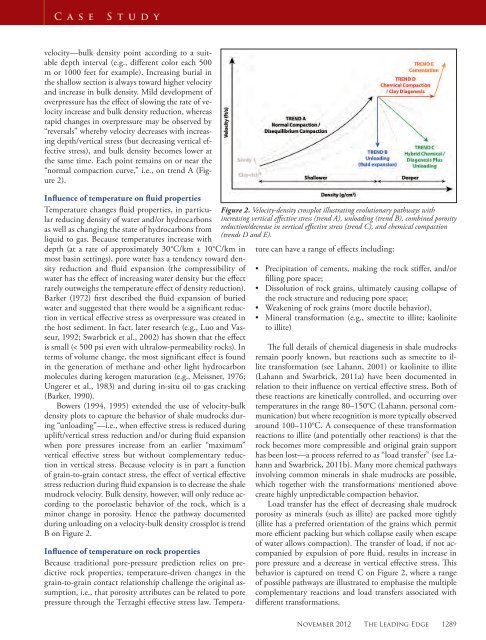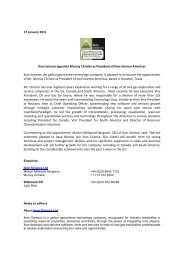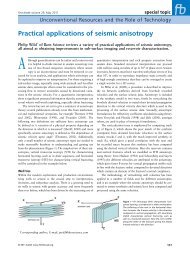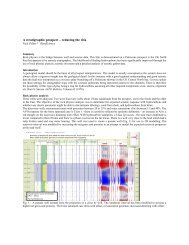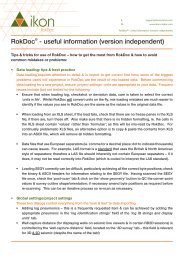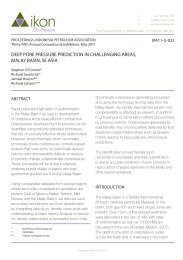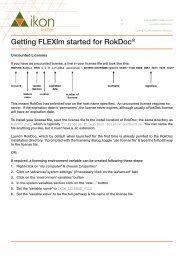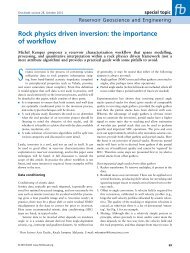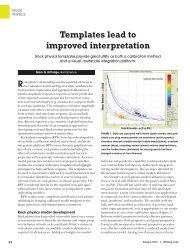Pore Pressure Prediction TLE Nov 2012 Swarbrick - Ikon Science
Pore Pressure Prediction TLE Nov 2012 Swarbrick - Ikon Science
Pore Pressure Prediction TLE Nov 2012 Swarbrick - Ikon Science
- No tags were found...
You also want an ePaper? Increase the reach of your titles
YUMPU automatically turns print PDFs into web optimized ePapers that Google loves.
Case Studyvelocity—bulk density point according to a suitabledepth interval (e.g., different color each 500m or 1000 feet for example). Increasing burial inthe shallow section is always toward higher velocityand increase in bulk density. Mild development ofoverpressure has the effect of slowing the rate of velocityincrease and bulk density reduction, whereasrapid changes in overpressure may be observed by“reversals” whereby velocity decreases with increasingdepth/vertical stress (but decreasing vertical effectivestress), and bulk density becomes lower atthe same time. Each point remains on or near the“normal compaction curve,” i.e., on trend A (Figure2).Influence of temperature on fluid propertiesTemperature changes fluid properties, in particularreducing density of water and/or hydrocarbonsas well as changing the state of hydrocarbons fromliquid to gas. Because temperatures increase withdepth (at a rate of approximately 30°C/km ± 10°C/km inmost basin settings), pore water has a tendency toward densityreduction and fluid expansion (the compressibility ofwater has the effect of increasing water density but the effectrarely outweighs the temperature effect of density reduction).Barker (1972) first described the fluid expansion of buriedwater and suggested that there would be a significant reductionin vertical effective stress as overpressure was created inthe host sediment. In fact, later research (e.g., Luo and Vasseur,1992; <strong>Swarbrick</strong> et al., 2002) has shown that the effectis small (< 500 psi even with ultralow-permeability rocks). Interms of volume change, the most significant effect is foundin the generation of methane and other light hydrocarbonmolecules during kerogen maturation (e.g., Meissner, 1976;Ungerer et al., 1983) and during in-situ oil to gas cracking(Barker, 1990).Bowers (1994, 1995) extended the use of velocity-bulkdensity plots to capture the behavior of shale mudrocks during“unloading”—i.e., when effective stress is reduced duringuplift/vertical stress reduction and/or during fluid expansionwhen pore pressures increase from an earlier “maximum”vertical effective stress but without complementary reductionin vertical stress. Because velocity is in part a functionof grain-to-grain contact stress, the effect of vertical effectivestress reduction during fluid expansion is to decrease the shalemudrock velocity. Bulk density, however, will only reduce accordingto the poroelastic behavior of the rock, which is aminor change in porosity. Hence the pathway documentedduring unloading on a velocity-bulk density crossplot is trendB on Figure 2.Figure 2. Velocity-density crossplot illustrating evolutionary pathways withincreasing vertical effective stress (trend A), unloading (trend B), combined porosityreduction/decrease in vertical effective stress (trend C), and chemical compaction(trends D and E).Influence of temperature on rock propertiesBecause traditional pore-pressure prediction relies on predictiverock properties, temperature-driven changes in thegrain-to-grain contact relationship challenge the original assumption,i.e., that porosity attributes can be related to porepressure through the Terzaghi effective stress law. Temperaturecan have a range of effects including:• Precipitation of cements, making the rock stiffer, and/orfilling pore space;• Dissolution of rock grains, ultimately causing collapse ofthe rock structure and reducing pore space;• Weakening of rock grains (more ductile behavior),• Mineral transformation (e.g., smectite to illite; kaoliniteto illite)The full details of chemical diagenesis in shale mudrocksremain poorly known, but reactions such as smectite to illitetransformation (see Lahann, 2001) or kaolinite to illite(Lahann and <strong>Swarbrick</strong>, 2011a) have been documented inrelation to their influence on vertical effective stress. Both ofthese reactions are kinetically controlled, and occurring overtemperatures in the range 80–150°C (Lahann, personal communication)but where recognition is more typically observedaround 100–110°C. A consequence of these transformationreactions to illite (and potentially other reactions) is that therock becomes more compressible and original grain supporthas been lost—a process referred to as “load transfer” (see Lahannand <strong>Swarbrick</strong>, 2011b). Many more chemical pathwaysinvolving common minerals in shale mudrocks are possible,which together with the transformations mentioned abovecreate highly unpredictable compaction behavior.Load transfer has the effect of decreasing shale mudrockporosity as minerals (such as illite) are packed more tightly(illite has a preferred orientation of the grains which permitmore efficient packing but which collapse easily when escapeof water allows compaction). The transfer of load, if not accompaniedby expulsion of pore fluid, results in increase inpore pressure and a decrease in vertical effective stress. Thisbehavior is captured on trend C on Figure 2, where a rangeof possible pathways are illustrated to emphasise the multiplecomplementary reactions and load transfers associated withdifferent transformations.<strong>Nov</strong>ember <strong>2012</strong> The Leading Edge 1289


